In this exercise we are asked to chose a scene from a movie, identify individual shots in the scene and then, for each shot, answer the following questions:
- How does the frame feel?
- How has this been achieved?
- Has the mise-en-scene played a part in this?
- Is there any meaning conveyed in the mise-en-scene?
This exercise has been one of the most enjoyable and mentally stimulating so far on this course (which is ironic since I chose such a bleak movie to analyse!). A shot-by-shot analysis has enabled me to see how the scene is ‘constructed’ and to stop and look at details that would normally be only fleeting if viewed without stopping.
I have chosen a scene from Blade Runner – The Director’s Cut where Pris meets Sebastian for the first time and he takes Pris up to his apartment. Every shot in Blade Runner contains significant mise-en-scene material that supports the underlying themes and meaning in the movie.
Blade Runner is a mixture between science fiction and film noir. Film noir is French term which translated literally a black film, however the term also refers to the dark story that the movie tells. According to www.filmsite.org, these films revolve around stories of ‘cynical, hard-hearted, disillusioned male characters who encounter a beautiful but promiscuous, amoral, double-dealing and seductive femme fatale.‘
The setting for the movie is a fictionalized Los Angeles in the year 2019 (I know that the Blade Runner parties for 2019 are already being planned!) and follows the story of an ex-blade runner (a replicant assassin) who has been coerced by the police to hunt and kill a group of replicants or genetically engineered androids, who have arrived illegally in LA.
I chose the scene where a replicant named Pris, is plotting to meet up with a genetic engineer, Sebastian, who would be able to help the replicants get into the Tyrell company building to confront their maker. This scene in the movie is the first time that the audience will meet Pris and it is not clear whether she is human or replicant although there are clues that help the audience to eventually work out that she is a replicant. The scene starts in the streets of LA and ends with Pris and Sebastian in his apartment.
The entire scene feels bleak, dark and oppressive. There is a sense of decay even though it is clearly meant to be an LA of the future. It is as if something catastrophic has happened sometime in the past and the city (possibly the entire planet) has not recovered. There is also a sense of paranoia – as if the society needs to be constantly and heavily policed to keep order.
The scene opens with Pris walking through city streets.
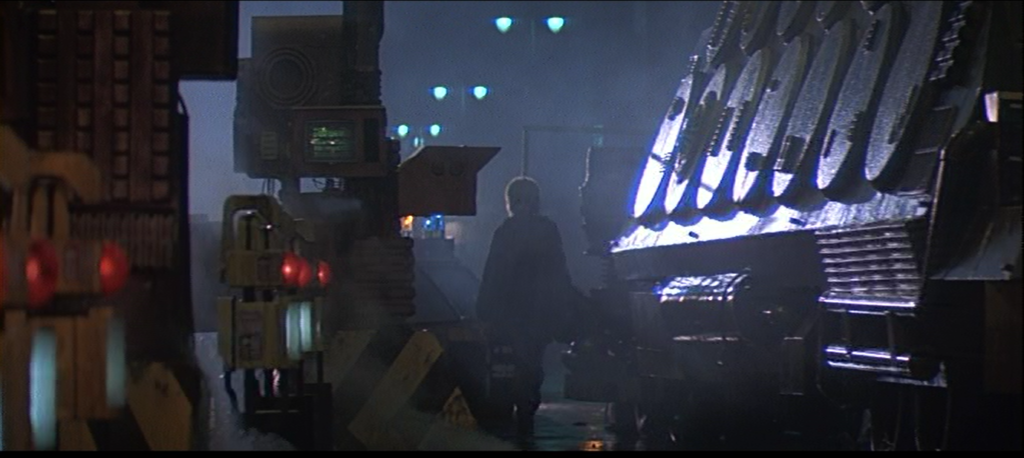
How does the frame feel?
Cold, oppressive and cluttered with ‘junk’. The scene is in the city, it feels threatening and there is a certain anticipation that something ‘not good’ is going to happen. It is probably night but since the movie never has any daylight it is hard to tell. This is the first time the audience meets Pris and at this point they do not know who she is. When she walks into full view, there is some mystery as to whether she should be regarded with distain or compassion; on the one hand she looks like a down and out prostitute and on the other hand she looks bedraggled and desperate.
How has this been achieved?
The set is made up of hard, industrial looking machines. Their function is not always recognizable; to the right of the frame there is a vehicle but it is not clear what the vehicle does. There are two structures to the left of the frame that are difficult to identify however the one closest to the centre has the look of some sort of monitoring device because it resembles speed cameras. The only identifiable structures are the chevron signs and the construction barriers.
The lighting in this shot is complex. The scene is top lit, allowing a cold blue-ish light to fall on the vehicle. Due to the various structures in the scene and the mist, the light falls as slanted rays of blue light. The street lights are dull by comparison with the top lighting.
Pris is backlit and so the audience is only able to see her silhouette as she walks along the street. At this point the audience cannot tell who she is as the backlighting hides her identity. There are various coloured lights flicking on and off which adds to the confusion of the scene. As the shot progresses, Pris walks into full view and the audience is able to see the detail of her clothing and hair through the grimy haze. She is dressed in clothing that gives the impression she is a poor prostitute – something that would not be out of place in this grimy city. She is damp and unkempt looking. As Pris walks into the close up, we can see that her hair is damp. The audience can see her face but it is in a dull shadow with her hair being backlit.
There is steam rising from the grates and manholes on the street and it is raining. It rains in most outdoor scenes in this movie making everything feel uncomfortable.
Has the mise-en-scene played a part in this?
All the structures and lighting are a part of the mise-en-scene. The arrangement of the structures creates a cluttered, temporary, disjointed feeling to the shot. The construction barriers create a sense of disrepair. The steam enhances the sense of an ‘evil’ and oppressive city.
Is there any meaning conveyed by the mise-en-scene?
The setting, which contains both recognizable and alien structures, tells us that this is a scene set in a future, decaying city. We already know from the beginning of the movie that this is Los Angeles in 2019. The entire shot supports the bleak atmosphere of the entire movie. The blue misty lighting enhances the sense of threat. The large structures and the disorganized arrangement reinforce the sense of threat to the person walking through them. As the story evolves, the audience will realize that this environment is hostile to Pris. Not being able to see Pris, due to backlighting, adds to the sense that we don’t know who this person is.
The second shot is of Pris still walking through the street but taken from behind.
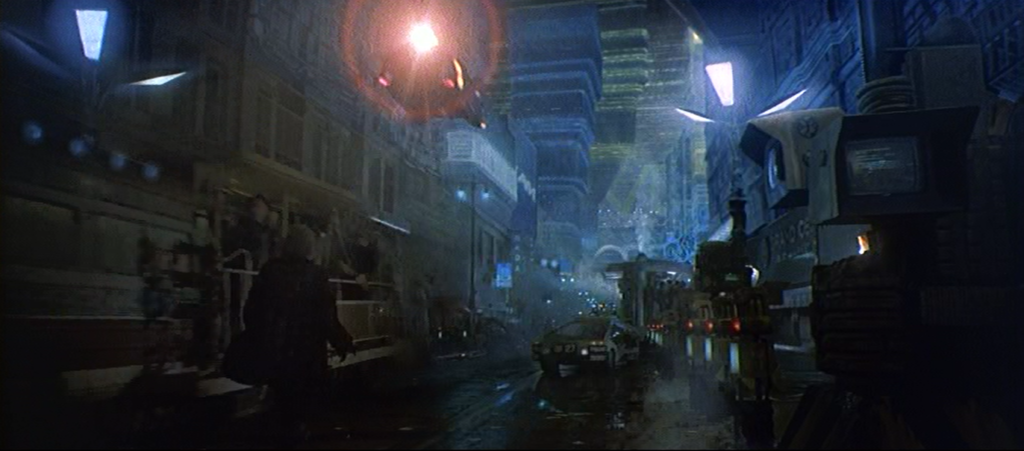
How does the frame feel?
This shot is a continuation of the previous one and feels similar; bleak, cluttered and cold but their is an added sense of building threat and paranoia that has been added.
How has this been achieved?
This shot enables the audience to see a wider shot of the city street and it serves to reinforce what was learnt in the previous shot. The buildings are high and seems to be constructed in a way that makes them look bound up in either concrete rope or alternatively neon-light wrapped around them. They are continuously shaded in a hazy or smoky blue light and everything looks cluttered, dirty and in need of repair. The street lights are shrouded in the blue mist. The steam continues to rise from the underground and the construction/repair barriers and lights are still evident.
The added action in this shot is the movement of various vehicles. A large vehicle, of unknown purpose but definitely not recreational or pleasure, drives past Pris – probably some type of cleaning vehicle. It passes quickly and very close to her – giving the sense that the driver doesn’t care if he splashes her or knocks her over. A second vehicle passes overhead that seems to have a spotlight attached and appears to be some type of surveillance vehicle. The last vehicle to move off from the side of the street is very definitely a police vehicle.
The sides of the street are filthy with bits of paper fluttering about as the vehicles go past.There is even a small fire burning on the side of the road; it looks to be a small pile of rubbish that is burning.
Has the mise-en-scene played a part in this?
As there is no dialogue in this shot, the entire mood is determined by the lighting, the buildings, the dirt, the surveillance vehicles and the cluttered placing of building and objects (and the music).
Is there any meaning conveyed by the mise-en-scene?
The dirt, the blue light and the smoky look all contribute to the sense that this is a world in decay and needing some sort of clean up. The clean up is in fact not really about the city but rather about the clean up of the society that has declined into a materialistic, disposable society (hence the clutter and lack of space) who have morally degenerated to the point where it is unclear if the replicants are more human than the actual humans.
The police and surveillance vehicles are showing that this is a society that is unraveling to a point where it needs to be heavily policed to presumably keep order. It also shows the paranoia of the people in power. This paranoia shows how ‘afraid’ the authorities are of the non-humans attacking them, but this is in some ways misguided because the fear should be that the replicants are becoming more human-like in their ability to be emotional and empathize, whilst the humans are becoming more thoughtless, racist and harmful.
I skipped the next shot of Pris walking through the city because it has the same mise-en-scene elements as the previous two shots.
The next shot is of Pris approaching a rubbish tip and hiding in it.
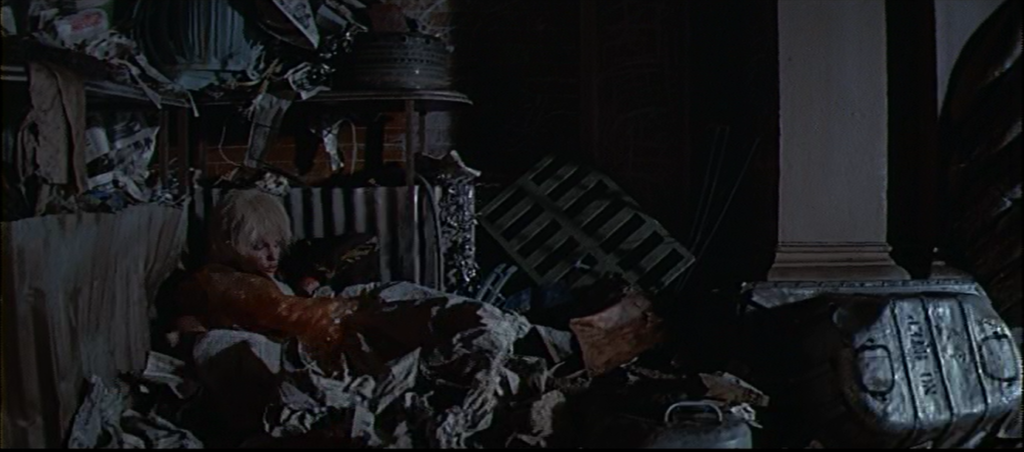
How does the frame feel?
This is a very clever shot because the audience feels sorry for Pris. The scene is desperate; Pris walks into view, smoking, looks around, tosses her cigarette away and then goes and sits amongst the rubbish. She covers herself with the rubbish and the audience is left feeling that she is probably destitute and has had to resort to sleeping rough and using rubbish to keep herself warm. As the story progresses the audience will slowly realize that this is not the case. In fact it is a calculated move on the part of Pris, designed to work on Sebastian’s compassion for the lost and lonely and to get him later to introduce Roy to his maker.
How has this been achieved?
The setting is the side of the street and the rubbish tip. The rubbish is overflowing from the tip itself creating the impression that it doesn’t get cleared away often. The rubbish consists of mostly large metal household items and cardboard/paper; dented metal crate, the large metal pot, the underside of a bed.
The light is dull with a lot of contrast and long shadows. The predominant colour is grey with tinges of dull red on Pris’s clothing, a small portion of the red brick wall that is seen through the rubbish and some of the rubbish itself.
Has the mise-en-scene played a part in this?
Yet again, there is no dialogue in this shot so the mise-en-scene is the major contributing to the mood of the shot.
Is there any meaning conveyed by the mise-en-scene?
The mise-en-scene conveys multiple meaning in this shot. Clearly the rubbish continues to support the notion that this is a society in decay and needs cleaning up, environmental and morally. However, the rubbish that Pris elects to hide also signifies that from the perspective of the society and possibly Pris herself, she is part of the rubbish that can be thrown away. The change of colour from grey-blue in the previous shots to grey-red in this one indicate a slight change of sympathies. The audience can feel a certain amount of sorrow for Pris’s circumstances, but not too much as they will later learn that the shot is not all it appears to be.
The next shot is of Sebastian arriving by vehicle, getting out and discovering Pris.
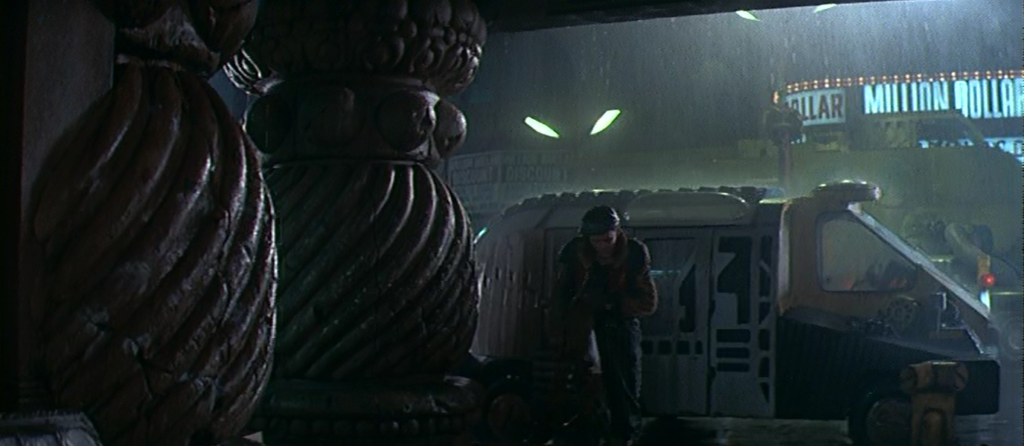
How does the frame feel?
It’s another depressing shot of a bleak society. Sebastian looks timid and insecure and we feel sympathy for him. When he discovers Pris and she tries to push past him and run away, the shadows and difficulty to see their faces makes you wonder what is not quite right; there is a sense that Pris is not completely authentic.
How has this been achieved?
It is a continuation of the previous grey-blue shots. It is raining heavily, the light is hazy through the mist and vehicles of unknown purpose pass by in the background. To the left of the frame are two enormous, ornate but cracked and chipped columns that are top lit and have deep shadows that emphasise the cracks. These columns remind the audience that this was once a wealthy, thriving city that could afford to have grand structures but is now is disrepair and decay.
The building behind Sebastian’s vehicle looks to be some type of gambling hall with the brightly lit ‘Million Dollar’ signs dominating the building front. Yet again an indicator of the type of society; drive by desperation (or greed) to seek their fortunate in establishments such as this one.
Has the mise-en-scene played a part in this?
Almost the entire mood is determined by the mise-en-scene.
Is there any meaning conveyed by the mise-en-scene?
The darkness and inability to see Pris completely when she scuffles with Sebastian adds to the sense that Pris is not only physically hidden in the shadow but also that she is hiding something.
The gambling hall in the background could signify that this is a society that not only gambles with money but also with other things; are they gambling with what it means to be human.
As Pris tries to run off, she slips on some of the rubbish lying on the pavement and this is what causes her to break her flight and stop and listen to Sebastian. The rubbish the society has generated stops Pris from running, but it is the same society that created this rubbish that stops her from living a long and meaningful life (bearing in mind that the creators of the replicants gave them a lifespan of only four years).
There are a series of shots that follow where Pris and Sebastian talk, which leads to Sebastian inviting Pris up to his apartment, which is exactly what Pris had been plotting from the beginning.
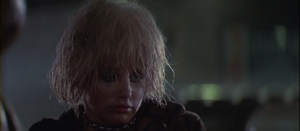
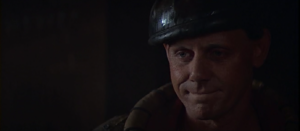
How does the frame feel?
Uncomfortable because suspicions about Pris’s nature are starting to become evident. This is the point at which the audience starts to suspect that Pris is probably a replicant and that her motives are dangerous for Sebastian. It is when Sebastian tells Pris his name, that the audience suspects that Pris has a purpose. Suddenly her lost and desperate persona is in doubt; is it a calculated pretense. At the end of the shot, when Sebastian turns away, there is a CU of Pris and the audience sees that her friendly, smiley expression were fake as her face relaxes and takes on a more devious expression.
How has this been achieved?
The dis-ease of the shot is driven primarily through the exchange between Pris and Sebastian. There is something almost child-like in their encounter and they are clearly awkward about how to proceed; however in the case of Sebastian this is because is a shy and reclusive person, whereas in Pris’s case because she has to find a way to get close to Sebastian.
The shots are primarily MCU and CU shots so that we can see the awkward body language of both them and the their reactions during the discussion. Sebastian’s clothing, although in muted browns, beiges and black is clearly of a better quality than Pris’s clothing, indicating that he may be living in slightly more fortunately circumstances. The strangeness of his clothing also indicates that this a different time to our own; there seems to a functional quality to the clothes that may be linked to the constant rain.
Both characters are lit with key lighting from one side only, which casts deep shadows of one side of their faces. Pris’s hair is backlit creating a halo effect. Although it is difficult to see their faces clearly, there is enough lighting to see that Pris’s eye make-up is very heavy and running. The lighting allows the audience to see that Sebastian’s skin is very mottled although the reason for this does not become apparent until later in the movie.
Has the mise-en-scene played a part in this?
The clothing, make-up and lighting is contributing to the uncomfortable feeling of this shot.
Is there any meaning conveyed by the mise-en-scene?
That Pris’s face is more hidden than Sebastian’s conveys that Sebastian is, in the context of his society at any rate, innocent, a bit naïve and basically a decent human, whereas Pris is hiding her true nature and purpose behind her heavily made up eyes. If the eyes are the window to one’s soul, then Pris, who as a replicant does not have a soul, is hiding this truth behind her heavily made up eyes. This theme will continue in later scenes where she sprays black paint over eyes.
In the next shot, which is very quick but significant, Sebastian is leading Pris to the elevator in his apartment block. The airborne advertising vehicle broadcasting a hope of a better life off the planet, passes overhead.
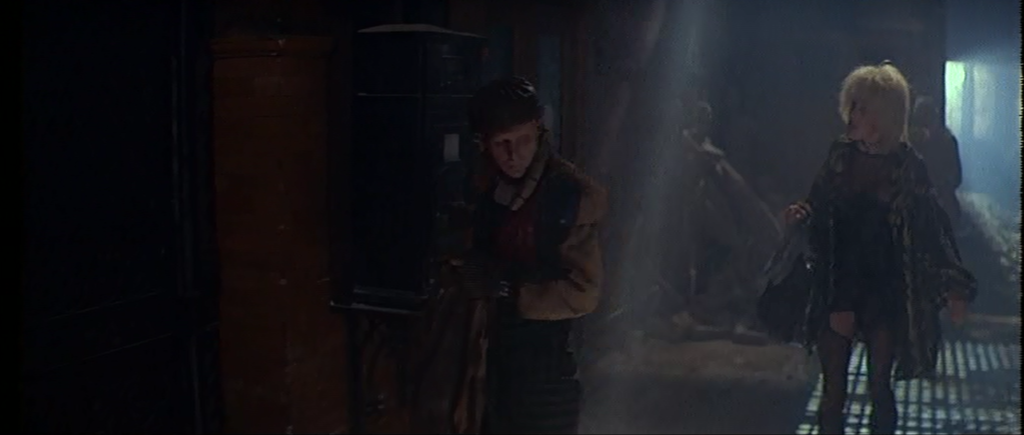
How does the frame feel?
Claustrophobic and creepy with an air of suspense and the threat that Sebastian is walking into a trap even though it is his own home.
How has this been achieved?
The ground-level inside of the apartment is littered with mannequins propped up against walls or fallen onto the ground. Everything is coated in a heavy layer of dust indicating that the place hasn’t been cleaned in years. At the same time, the quality of the elevator material and the size of the entrance indicate that this must once have been a grand building.
The lighting comes from the airborne vehicle spotlights shining through the open frame of the roof of the atrium. It casts moving light over the shot, at times highlighting Pris and them moving off. The moving light creates a slight sense of disorientation.
There is a constant light coming from somewhere above that creates grid line shadows on the floor where Pris is walking. What is odd about this setting is that even though the atrium is clearly large, it still feels claustrophobic due to the lack of light and the junk lying around.
Has the mise-en-scene played a part in this?
The moving lighting, the dirty setting and the darkness are all contributing to the building suspense in the shot.
Is there any meaning conveyed by the mise-en-scene?
The most obvious meaning comes from the cage-like shadow that is cast on the ground where Pris is walking. There is mostly likely a double meaning in this cage; firstly we suspect that Sebastian is on the path to being trapped by Pris, but secondly, although it is Pris doing the trapping, she is in fact the one who is trapped in a cage she cannot break free from. Her life, the value of her existence and her purpose have all been determined by someone else and although she is trying, she cannot determine her own destiny.
The next shot is very brief; a wide shot of the atrium as the elevator goes up to Sebastian’s apartment.
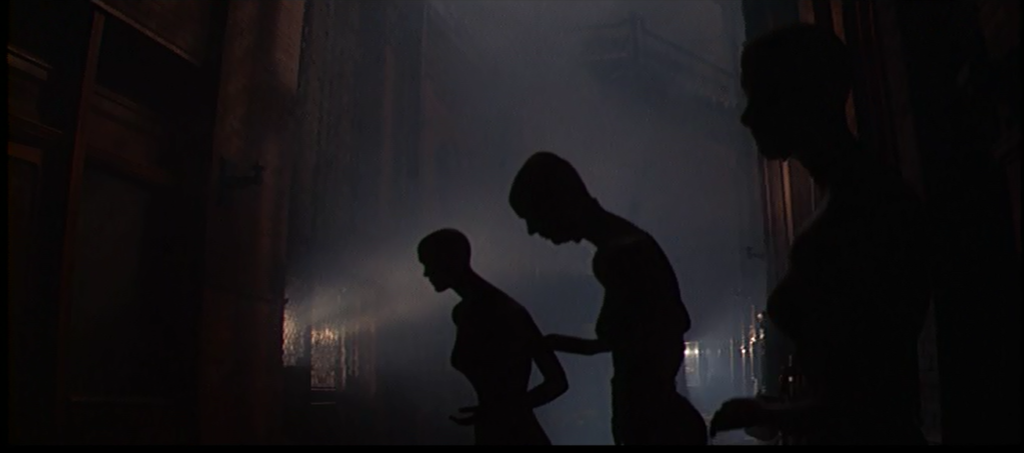
How does the frame feel?
Although a very quick shot, there is a feeling that this shot is critical to the meaning of the scene and for that matter the entire movie. At the same time, it is the ultimately creepy shot.
How has this been achieved?
As with the entire movie, the shot is dark and it is difficult to see. However, in this case there are two points of interest that draw the audience attention. These points ofinterest interact with each other. The first thing is the silhouetted line of three mannequins in various poses but all indicting some sort of ‘desperation’ with their hands outstretched. The second is that the silhouetting effect is coming from the light in the elevator as it rises to take Pris and Sebastian to the upper floors. Everything else is in darkness. There is an interplay between the mannequins and the light from the elevator.
The lighting is a mix of yellowish light from the elevator and a touch of blue light as it penetrates the atrium.
Is there any meaning conveyed by the mise-en-scene?
Absolutely. The mannequins signify the desperation of Pris and her fellow replicants to become or be valued as something human. However mannequins are inanimate and will never be human no matter how much they may look like humans. The light in elevator going up represents the hope of Pris, a ‘flesh and blood’ replicant, that she will find a way to become human. Unfortunately, this scene also hints that her hope will never be fulfilled because even though she is made of flesh and blood, she is still just a genetically-engineered mannequin and in some ways no different to the mannequins on the ground floor.
The next shot is of Pris and Sebastian getting out of the elevator and walking to the apartment
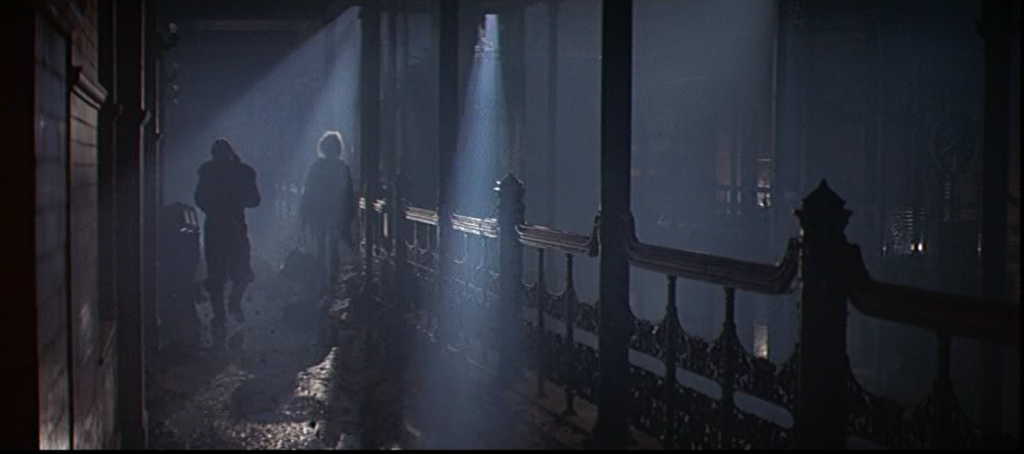
How does the frame feel?
The tension is building in this shot. It’s still dark and ominous with decay all around, leading the audience to feel that nothing good is about to come of entering the apartment.
How has this been achieved?
It becomes more apparent that the building was once a grand building that is now in decay. The balustrades are highly ornate, the atrium is high and spacious – it all harks back to a previous, more luxurious time. However, the corridor is filthy with dirt and water puddles on the floor. The roof must be broken allowing the rain to come through. The lights are not working since the only lighting is coming from the outside; most likely the airborne advertising vehicle because the blue spotlights keep moving around casting shifting shadows on the corridor. This lighting creates strong contrasts and puts both characters into deep shadow whilst emphasizing the dirt on the floor. It also gives a dynamic but disorientating feel to the shot.
Pris is yet again backlit and her hair looks as if it has a halo around it whilst Sebastian is completely in shadow.
When Sebastian and Pris get to the impressively big apartment door, the overhead spotlight momentarily lights up the entire shot.
Is there any meaning conveyed by the mise-en-scene?
Pris seems to have her head backlit often and I wonder about how much meaning is intended with this. Could it be that she is being likened to an angel? This is hard to understand as she is a desperate figure, at times calculating and at times pathetic. She is a follower, doing Roy’s bidding and clearly committed to him. Could the halo be a reference to the innocence of an angel?
At the end of the shot, the overhead lighting lights up the entire scene and we can see the door and Sebastian clearly. It is at this moment that the audience become absolutely sure that Pris is a great danger to Sebastian. Sebastian explains that he is a genetic engineer and then asks Pris if she knows what that is; to which she replies, whilst hidden in the shadows, that she does not. This is without doubt a lie. It is at this point that the scene is lit up by the spotlight – it is now certain that Pris is dangerous.
In the last shot, Pris and Sebastian enter the apartment.
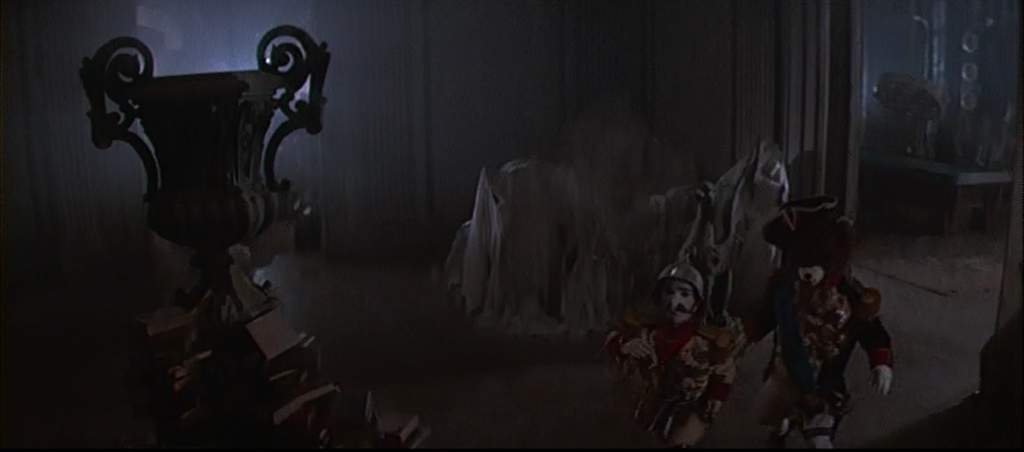
How does the frame feel?
Dark, threatening and yet again very creepy.
How has this been achieved?
The creepiness comes primarily from the entrance of the toy soldiers; a dwarf-like character and a cuddly bear that is looking decidedly not cuddly with is animated movements and outfit.
Furniture is covered with white, dusty sheets and there is a large vase dominating the shot. The vase is surrounded by and propped up by a disorganized pile of books. The room has odd ornaments placed here and there, creating a disorganized mess.
As with most scenes, the lighting is dark and it is hard to see anything clearly. When there is light, coming presumably from a window in an adjoining room, it is hazy, blue-ish and shows up the dust floating in the apartment.
Is there any meaning conveyed by the mise-en-scene?
The entrance of the two toy soldiers must be seen as the counterpoint to Pris; they are life-like, they speak, they walk, they seem to be thinking independently, but they are clearly not human. Is Pris closer to these toys, or closer to humans?
These toys also create a comparison between Sebastian and the Tyrell, the owner of the company that makes the replicants. Sebastian is seen as a small-time genius able to create life-like creatures from the rubbish he finds around him. His creations are creepy and childlike. Tyrell is the big-time genius, his creations are replicants that are so human-like they need a test to determine if they are human or not.
The darkness of this shot is setting the scene for Sebastian later falling into Pris and Roy’s trap and agreeing to take them to meet their creator. This step will eventually end in Roy killing Sebastian in whilst in a rage.
Images taken from: Blade Runner – The Director’s Cut [Feature film, DVD] Dir. Ridley Scott. The Ladd Company, Shaw Brothers, Warner Brothers. USA, UK, Hong Kong. 1982. 117 min.
http://www.filmsite.org/blad.html (Accessed on 15th April 2016)
